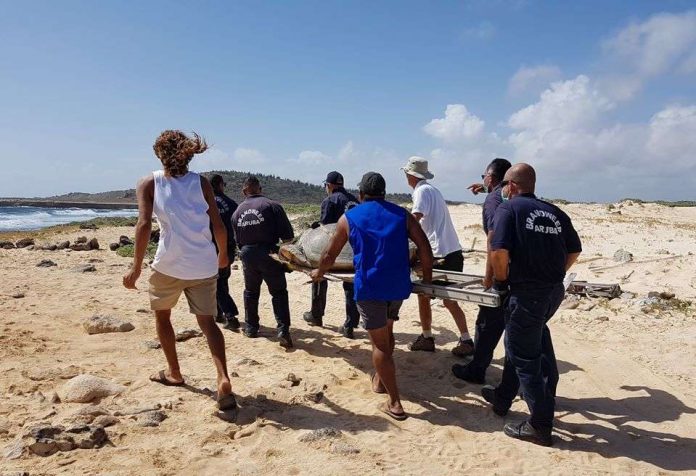Thursday morning Turtugaruba volunteer Miguel encountered a green turtle lost on land, wandering over painful rocks. It was not possible to guide her back to the sea. Foundation Turtugaruba called for assistance and the Aruba Fire Department responded. Together they managed to help the turtle return into the ocean.
Turtugaruba was founded on September 3rd, 2003 by a group of enthusiastic volunteers. Ten years earlier, in 1993, a Sea Turtle Recovery Action Plan (STRAP) was introduced in Aruba and the rest of the Caribbean as an initiative of the United Nations Environment Program (UNEP). Tom Barmes, who was working at DLVV (Deptartment of Agriculture, Husbandry and Fishery) was one of the writers of the STRAP for Aruba, together with Karen Eckert, director of WIDECAST (Wider Caribbean Sea Turtle Conservation Network). This is how sea turtle conservation started on the island following a plan that is still complied with today.
There are 4 different sea turtle species that visit Aruba to lay their eggs, each with their own specific season:
– Leatherback Sea Turtle – Lederschildpad – Driekiel (March – September)
– Loggerhead Sea Turtle – Dikkopschildpad – Cawama (May – September)
– Hawksbill Sea Turtle – Karetschildpad – Caret (June – December)
– Green Turtle – Soepschildpad – Turtuga Blanco (July-November)
There also came a better understanding and overview of the biggest threats to the sea turtles existence in Aruba and how these problems should be tackled. Despite hard work, all those years, most problems have not really gone away, but luckily and thanks to the enormous efforts from the volunteers, the sea turtles are still here. On Aruba the sea turtles are threatened with extinction by pollution, driving on dunes and beaches with quads and 4×4’s and the loss of nesting beaches due to coastal development on behalf of tourism. Because coastal development comes with artificial light and artificial light is a mayor issue for sea turtles, mother turtle usually comes on shore at night looking for a dark beach to make her nest. However… a dark beach is hard to find here nowadays. Light causes stress and can result in her returning to the sea without laying her eggs. Artificial light causes disorientation for the baby sea turtles (hatchlings). Despite the threats that exist on Aruba, the turtles still keep coming. That’s why today Turtugaruba is especially proud of the volunteers and the many people and organizations of our community that carry a warm place in their hearts for the sea turtles. All four species are active now, which means all hands on deck in the field for us, the volunteers. We strive to keep the sea turtles, our oldest ‘repeat guests’, always coming back to Aruba and get the chance to reproduce here. For more information have a look at the Facebook page Turtugaruba.

















